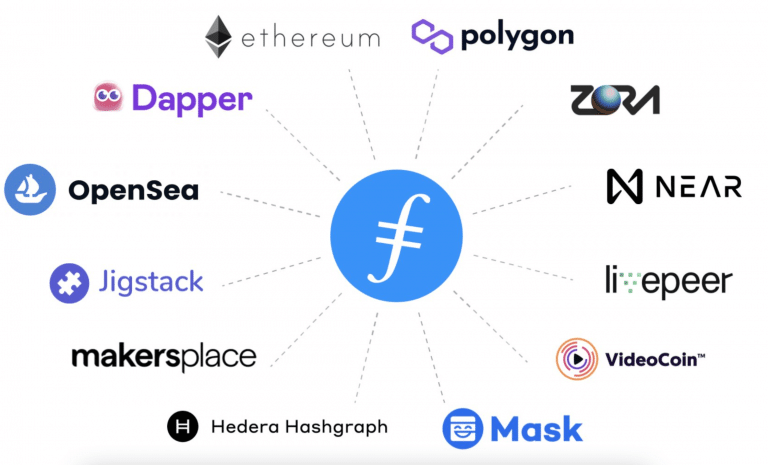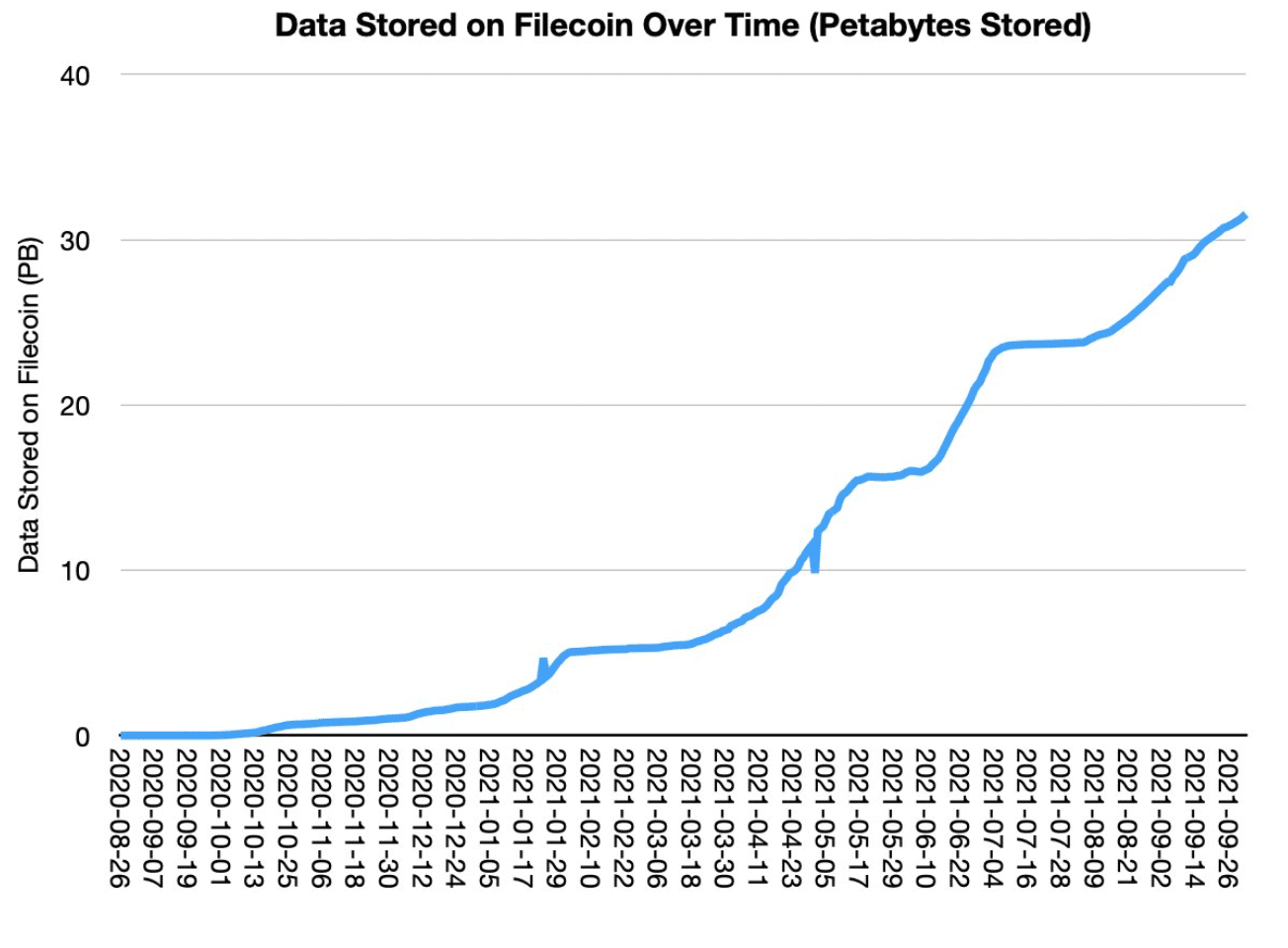Created by the developers of the Web 3.0 protocol InterPlanetary File System (IPFS), Filecoin (FIL) is a blockchain dedicated to decentralised data storage. Its competitive pricing, high-performance security architecture and commitment to safeguarding humanity’s data make it a benchmark for decentralised storage. Let’s take a closer look at what Filecoin offers and the roles of its FIL token
What is Filecoin (FIL)
The Filecoin project was born in 2017 in the United States. The idea behind the project is to create an open source decentralised storage network, allowing its users to store files in the cloud using blockchain technology.
Filecoin poses as a competitor to cloud storage services such as Google Drive, Dropbox and OneDrive. These are obviously centralised.
Decentralised cloud storage with Filecoin could be compared to the property rental market with Airbnb. Anyone can rent out a flat they own. The concept is similar with Filecoin. Here, a person with available storage space can rent it out on the Filecoin network, with the difference that no centralized entity manages this infrastructure. Filecoin is not the only player in this field. Other protocols such as Storj, Sia and Arweave also operate in this sector. However, at the time of writing, Filecoin is the most advanced in the sector in terms of the number of users and the amount of data stored.
Filecoin is based on the InterPlanetary File System (IPFS) protocol. It allows data to be stored and shared over a decentralised network. This Web 3.0 protocol is also created by Protocol Labs, the company behind Filecoin.
On the cusp of intense competition for market share in cloud storage, a market that is growing exponentially and is estimated to be worth $137 billion by 2025 ($50 billion by 2020), what does Filecoin have to offer?
With its business model, Filecoin allows users to rent storage space in exchange for FIL tokens, the native cryptocurrency of the Filecoin network. Data is encrypted end-to-end to secure the protocol, preventing censorship and tampering. This means that every file is stored correctly and reliably, so users don’t have to worry about data loss.
Any type of data can be stored. Databases, websites, personal and business data, contracts and much more. All at competitive prices, customised according to use, time and type of data stored.

Filecoin logo (FIL)
The Filecoin ecosystem
Filecoin is therefore developed on the IPFS protocol. The miners, in this case the participants providing storage on the network, have to prove that they are storing the data correctly over the defined time period. Cryptographic proofs guarantee the availability and immutability of the data.
Proof of Spacetime and Proof of Replication
Thus, the Filecoin protocol is based on the Proof of Spacetime (PoSt) consensus. It allows the verification of all or part of a file in order to confirm its storage without alteration over the predefined period. Miners are randomly selected to check the data stored by them. This is to ensure that they are participating honestly in the network. Financial compensation in the form of FIL tokens also encourages this behaviour.
At the same time, the Proof of Replication (PoRep) verifies that the number of copies of a file is stored as predefined in a unique way. In concrete terms, the miner proves that it is indeed storing part of a data item, and that the data cannot be replicated by another miner. This therefore ensures its availability.
As a result, the Filecoin blockchain verifies the proofs and the data is therefore stored correctly and securely.
A diverse ecosystem
With Filecoin it is also possible to store smart contracts (escrows, insurance, auctions, games, etc.), metaverse assets or even the metadata of non-fungible tokens (NFTs) for example. The Filecoin network offers many storage possibilities.
Filecoin also aims to preserve public data. The entire Wikipedia database has been stored on its network, as has Project Gutenberg’s database (more than 60,000 open access e-books).
Wikipedia, OpenStreetMap, gnomAD, Project Gutenberg, and OpenAQ are just some of the treasured data archives stored on the Filecoin network. Explore some of these projects on the Filecoin website: https://t.co/hKQI5O3F6h
– Filecoin (@Filecoin) April 1, 2021
In addition, the Filecoin Virtual Machine (FVM) was introduced in October 2021, a tool that could become one of the pillars of decentralised storage.
Among other things, the Filecoin Virtual Machine allows calculations to be made directly on the space where the data is stored (which gives the Filecoin network computing power via the FVM). All without transferring them elsewhere. It will also facilitate a business model for tokenising data, a very promising innovation for this market.
The FVM also supports interoperability by allowing the integration of decentralised applications (dApps) from other blockchains such as Ethereum or Solana, with Filecoin providing the storage function for these dApps.
It is also compatible with the Ethereum Virtual Machine (EVM), offering many possibilities for developers.
In order to participate in the Filecoin network, i.e. to make storage space available, store data or buy data, one should ideally use Slate or Lotus. Slate allows you to use the Filecoin network with a more accessible interface for the less tech-savvy. Lotus is the official client to use for people who want to make their storage space available
What is the purpose of the FIL token?
The FIL token is used to pay for the rental of storage space. Thus, miners are paid in FIL. The special feature of the Filecoin blockchain at this level is that it can offer these services at extremely competitive rates compared to centralised solutions. The price is determined on the principle of supply and demand (free market). Competition is therefore highly encouraged.
Filecoin thus reduces the barriers to entry to participate in the network as a miner. It makes cloud storage a commodity. This makes it easy for new entrants to compete with established players.
The latter compete to store data and offer flexible options at the best prices, and do so transparently.
Another feature for Filecoin users is the ability to tailor to specific needs, be it redundancy, retrieval speed, storage duration or cost. This makes pricing very customisable.
As we have seen, Filecoin allows anyone to monetise their storage space. Storing data directly earns FILs. It should be noted that in order to store data, you must first allocate FILs as collateral, so it is necessary to own some. This is an additional security to ensure that miners are participating honestly in the operation of the network.

Relationship between WIRE rewards and amount of storage
The probability of earning the WIRE reward of a block and transaction fee is proportional to the amount of data the miner allocates to the Filecoin network.
They are also rewarded for the speed with which they deliver the content they have stored. The data retrieval market is attractive to miners who have low latency connections and high bandwidth in close proximity to users. These well-placed storage providers are compensated in FIL by providing files and data at the highest speeds.
Finally, the quality of the data (value, popularity) is taken into account when setting the price.
Filecoin fundraising and FIL features
Filecoin fundraising
The Filecoin Initial Coin Offering (ICO) took place in October 2017 with an initial price of $1.30 per FIL token. With $257 million raised, it is still one of the most successful fundraising projects in the ecosystem. Note that the ICO was only open to accredited investors and not to the public.
Filter features
There will be a maximum of 2 billion (cap) FIL. The market capitalisation at the time of writing is $6.5 billion. There are also penalties for network participants who are not honest (for example if data is lost). Their collateralized FIL tokens can simply be burned. The other burn mechanism on the network concerns transactions. A small part of the fee for each transaction is burned to compensate for the expenditure of network resources.
In terms of the distribution of tokens, 10% were sold at the ICO, 15% are allocated to the development team and 5% to the Filecoin Foundation.
The rest is distributed over 16 years to miners as block rewards.
Team and partners
Filecoin team
Filecoin is a project of Protocol Labs, an open source research and development lab. It is the company behind the IPFS protocol or libp2p. They have a team of over 100 employees.
There is also the Filecoin Foundation (FF), an independent organisation that facilitates the governance of the Filecoin network, funds project development, supports the growth of the Filecoin ecosystem and promotes the decentralised web. The foundation’s board of directors includes such figures as:
- Sandra Ro, CEO of the Global Blockchain Business Council;
- Brewster Kahle, co-founder of the Internet Archive;
- Marta Belcher, General Counsel of Protocol Labs and President of the Filecoin Foundation. She was previously a lawyer specialising in blockchain and emerging technologies;
- Juan Benet is the CEO of Protocol Labs and a graduate of Stanford University. He is the founder of the Web 3.0 protocol InterPlanetary File System (IPFS) in 2014;
- Molly Mackinlay, also a Stanford graduate, is responsible for the design of the Filecoin protocol as well as a project manager on IPFS, after 5 years of experience at Google.
Filecoin partners
Filecoin is working with many strong partners in the cryptocurrency ecosystem.
Hedera Hashgraph joins Filecoin in July 2021 to advance Web 3.0 interoperability. In August 2021, Filecoin and Polygon announced a cross-chain bridge between the two projects to also accelerate Web 3.0 interoperability.
In September 2021, the Ethereum Foundation, a non-profit organisation dedicated to the development of the Ethereum network, Filecoin and Zcash signed an agreement to improve interoperability between the three blockchains. Indeed, this agreement allows the storage of Ethereum smart contracts on the Filecoin blockchain, while protecting them thanks to the Halo 2 protocol of Zcash. This protocol will ensure the confidentiality of transactions.
In October 2021, Filecoin became the official storage partner of the Flow blockchain. Flow users can store the metadata of their NFTs via the IPFS protocol on Filecoin.
Finally, in November 2021, Filecoin and NEAR Protocol announced a $300,000 program to strengthen cooperation between the two ecosystems.

Partenaires de Filecoin
How to buy FIL tokens
FIL is available on almost all trading platforms in several pairs. You can get them by going to Binance, Huobi Global, Kraken, Coinbase, KuCoin or Gate.io.
Notes and opinions about Filecoin
Filecoin is a solid project backed by a company (Protocol Labs) that has already proven itself with IPFS. What sets it apart is its decentralised network, ensuring privacy and protecting data from censorship or hacks. Its blockchain properly rewards network participants thanks to its unique business model based on customisable rates and free market.
This makes it an interesting option in the cloud storage market as the costs for users are very low.

Data stored on Filecoin
At the time of writing, the Filecoin network is producing 33 petabytes of storage capacity, and over 3,500 storage providers (miners). The use of the network is growing rapidly and is therefore convincing.
Filecoin stores around 8 million NFTs on its blockchain, that’s almost 1 NFT per second. Filecoin therefore has a very important place in this growing sector, and by extension will benefit from the growth of metavers. Indeed, NFTs are key assets in metavers. Filecoin is therefore in a prime position to benefit from the evolution of these technologies through its decentralised cloud storage function.
However, it is important to keep in mind that Filecoin is competing with well-known projects such as Storj, Sia, Arweave or even more recent projects such as Cere Network. This juicy and growing market is attracting and will continue to attract new competitors. Filecoin is currently not very user-friendly, although there are solutions such as Slate, but the team is working particularly on this aspect.
This does not detract from Filecoin’s advantages, the network is not the market leader in decentralised cloud storage for nothing. The network has a good track record, a strong development team and its foundation support its growth while its infrastructure is very robust.
The Filecoin Virtual Machine, currently in phase 0, expands the network’s capabilities tenfold. Finally, the Filecoin network benefits from first-class partners such as Ethereum, Near Protocol, Polygon and Opensea.
